How to Make Your Marketing More Transparent
One of the most effective ways to gain more customers, and to make your customers more loyal is to become more transparent as a brand.
This topic is a bit tabu among many marketers and leaders because they are scared to death that the public will spot any flaws they might have.
So they become as private as they possibly can, not letting anyone in on their brand secrets.
And it’s not strange really. For a long time, the way to success has been to put your brand on a pedestal and present yourself as a pig in disguise, dressed out like a model. And the thing is, it has worked.
Back in the days, brands could be unethical and sell you products that didn’t work, or lie about things, simply because people couldn’t get ahold of the real truths, nor could they tell anyone else about it, other than their closest friends.
But a shift has happened as the age of digital has risen. The internet has given even the quietest consumer a voice that reaches many.
It’s no secret that marketers always highlight the best in a product or brand and leave the less positive things out, but by being transparent, you show it all. Being open about your business is an incredibly effective way to gain people’s trust and loyalty – something you should always strive towards as a brand.
Because if your audience doesn’t trust you, they won’t buy from you!
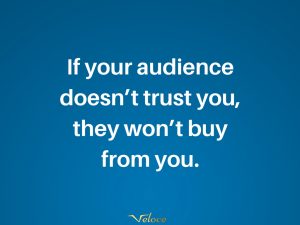
You can be how private you want with your business, but the catch is that if you don’t share them, your customers will do so for you, and what do you think will have the best effect?
If you point out your own faults and admit them, or, your customers doing it for you?
Due to the power of today’s consumer, that can share a review on sites like Yelp, Tripadvisor, or social media, your every move is studied carefully. People will listen to your marketing, but the only difference now from back in the days is that if your marketing is false, people can raise a voice about it and make other people aware.
Today, your job is to ensure the reality lives up to the marketing promise.
In this article, we’re looking at a topic many brands are scared to death to even mention. We’ll learn How to Make Your Marketing More Transparent
What is transparency in marketing and why do you need it?
Let’s start with the basics. Obviously, we know what the word transparent means, but what does it mean applied to marketing and business?
The explanation is very simple, really. Here’s how Merriam-Webster defines transparency “Characterized by visibility or accessibility of information especially concerning business practices.”
What’s more, Joe Pulizzi says:
“Your customers care more about your knowledge than they do about your products.”
And in today’s market, it’s hard to pretend like you know everything because people have the real answer right at their fingertips.
Transparency in business is ultimately about being honest and open with things that discrete brands would classify as ”top secret”, and it is also about letting your customers in on things that are otherwise difficult to get the answer to.
When you are being transparent, you need to make sure that it isn’t forced because you know that it has great marketing results. Instead, it should be embodied in your brand’s personality and the way you are. Transparency needs to happen naturally.
A simple explanation of the term is the following:
”A brand is considered transparent when much knowledge is available to the public”
But there’s a catch though. Obviously, a lot of information is available about Coca-Cola, however, I’m not so sure that they are transparent.
Therefore, it’s more about the information that brands often keep to themselves that makes them transparent or not, because you can stand there and bash out information about your brand and keep all the private things for yourself, but that won’t do much good for your transparency anyways.
Transparency in business is something that customers and the evolution of the society have forced brands. Obviously, far from every brand has jumped on the train, but looking at the current state of the customers and what they expect from brands, transparency is no longer becoming an optional choice, but more so, it’s becoming a crucial necessity for all brands.
A common argument that I often hear when the topic transparency is brought up is ”But if I tell all my numbers and everything about my business, my competitors will copy me”.
But obviously, that’s not true.
It doesn’t matter if your competitors know what you are doing because what works for you might now work for them. And what’s more, by doing the best possible work, and fine-tuning whatever you’re doing to perfection, your competitors won’t be able to pull it off or reach the same results as you.
Plus, when they are about to copy you, you’re already planning the next move, making you always one step ahead.
For instance, how does the revenue numbers of Coca-Cola help Mountain Dew?
Not that much, right?
Customers want to know how a business is run, where your products are produced, what happens behind the scenes, and much more. But if they can’t get that, there’s a risk that they’ll be moving on.
In today’s world where more and more people are taking action about where the things they buy come from, in order to decrease their impact on the environment, people are more aware of the choices they make. And if you are either hiding the truth they want to access – whether it be the truth they want to see or the opposite, you’re going to lose more customers by not being transparent than you are being transparent.
Apart from the fact that transparency allows you to become more trustworthy, and makes your audience more loyal, it helps you do one more thing: differentiate yourself.
Especially in the online world, there’s a lot of noise, and getting heard is tremendously difficult. Therefore, in getting heard, you need something that cuts through the noise and gets you heard.
Transparency is the answer.
Dominos pizza is one of the best examples of a brand that has done transparency correctly. In 2008, the company surveyed customers in order to find out what was wrong with their service. Unlike what the vast majority of brands would do, they presented the feedback publicly, even though some of the feedback was vicious.
But they didn’t do so become more transparency, but instead, they shared the feedback publicly and asked their audience to help them.
At the time when this happened, their stock price was around $7.73. Today, their stock is around $130 per share. Now obviously, all of this isn’t thanks to this one act, however, it had a huge impact on the business.
Today, you need to put honesty first, because when you make yourself appear more honest and transparent, you increase your brand loyalty, your audience’s trust, as well as strengthen your brand image.
Here’s how you do that:
How to become more transparent in your marketing
Create advocates
This is also a benefit of being transparent, but the good news is that your current advocates can draw new ones into your brand!
In other words, you can make people advocates for your brand, for example by building communities and engaging with them, but you can also gain advocates by becoming more transparent.
Now, you might be thinking ”so he’s telling me to be more transparent before telling me how?”. But here’s the deal:
Advocates are tremendously valuable for brands as they go around talking about your brand to their peers, and telling everyone how awesome you are. And as you know, word-of-mouth marketing is one of the best forms of marketing that holds the most trust.
The reason?
92% of people trust peer recommendations.
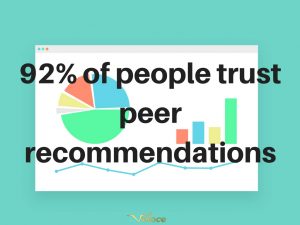
But here’s the best part:
when you work to get brand advocates for your brand for example by engaging with them on a regular basis, you will have them go around talking about your brand to their peers and friends. And the whole reason why the vast majority of people trust peer recommendations is that they have no hidden agenda. Everyone knows that brands only want one thing: to see more, so obviously, the things that the brand will say will be to reach that goal.
With advocates, on the other hand, your brand will become more transparent, without having to do anything!
And when your advocates talk about your brand and make it more transparent, more customers will come your way.
Mat Franken says this:
When buyers make purchases, they want to know their decisions are good for their family and align with personal or charitable interests. Trust can’t be bought. It must be earned. Consumers want to understand exactly what they are buying, and rightly deserve the knowledge they seek.”
Optimize your website to make your brand more transparent
Your website probably tells your audience a lot. Whats’ more, you probably have a ton of content on it where you tell people who you are, what your company does, and what your mission is.
Many times, your website is the place people will go to learn more about you, to contact you, or even buy from you. Everything you do in terms of transparency should, therefore, be presented on your website.
Remember that when people are going to buy something online, it’s seldom that they go directly to the product they like and then click order. Often times, they scroll around the website to see if they can trust it. This is why it’s so crucial to have a lot of information on your site about your brand that makes the customer more secure in buying from you. And regarding establishing trust, the thing that makes your audience trust you the most is being transparent.
Mcdonald’s has realized this and has created a page on their website where they respond to customer questions. Apart from making their brand more transparent by responding to often sensitive questions, it also gives them an opportunity to bust common myths and clarify things people are wondering about.
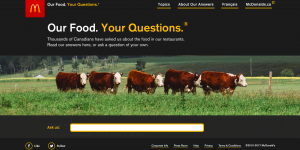
The bottom line is that the content on your website needs to make your website visitors feel like they know you and that they can trust you. Not only will this lead to trust short-term, where they trust you to the point where they’ll buy from you, but it will also be the starting signal to establishing a long-term relationship with them.
Create a FAQ page on your website
As a brand, I am sure you’ve received several questions that you preferred not to answer because the answer wouldn’t be very appealing. So, instead, you tried to talk yourself out of the question, and the whole situation was just awkward.
Sounds familiar?
The thing is, brands believe that if their response isn’t that good, or more so, not the answer that people ideally want to hear, it is better to tell half-truths, or try to meander their way out of the question.
But the reality is that people appreciate when you tell the truth. It is easy to spot when someone is lying or not telling the whole truth – especially with brands, and even if the answer isn’t that appealing, be transparent and admit it, and then explain the choice you’ve made, or even explain your future plans for changing what you are not so proud of.
Just like McDonald’s has, you should create a FAQ page and a page where people can ask questions on your website. If you want, you can even add questions that you are receiving on places like social media to the question page, because the more information and answers you give, the more transparent you become.
But if you’re going to have a FAQ page on your website, make sure you give the answers people are looking for.
Just because you set up a FAQ page doesn’t mean you’ll become more transparent. In fact, it can be the opposite.
It’s more about how you respond to the questions you are receiving, and if you’re giving them the full truth.
Coca-Cola’s response regarding this question on their FAQ page, for instance, wasn’t very helpful. After all, they don’t answer the question:
The question asked gives them a tremendous opportunity to be transparent and become more trustworthy, but instead, they blow it all.
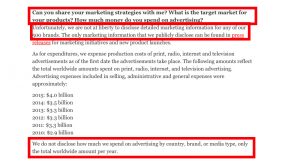
Share customer testimonials
As mentioned earlier, having your audience talk about your brand is tremendously effective in marketing as they are far more trusted by their peers than brands are.
According to Cohn & Wolfe’s 2017 Authentic Brand study consumers value brands that are authentic. Globally, 91 percent of consumers said they are willing to reward a brand for its authenticity by recommending the brand to friends or buying the product.
What’s more, 62 percent said they would either purchase a product from that brand that they deem to be authentic or express greater interest in buying from that brand in the future.
There is no doubt that authenticity is vital to success as a brand, and the good news is that customer testimonials from your existing customers help you become both more transparent and authentic.
When it comes to transparency, testimonials and reviews are some of the most effective ways to establish yourself as transparent. The reason is that instead of being the one who talks, your audience talks for your due to their trust, what they’re saying has a bigger impact, and gives a new angle to your business – an angle people might not have known about before.
According to a study, 94 percent of b2b marketing and sales professionals found that honest customer reviews as very effective.
The best part about customer testimonials, believe it or not, is that they are both negative and positive. In fact, 30% of consumers assume online reviews are fake if there are no negative reviews. Therefore, showing everyone both positive and negative reviews of your brand allows you to become more transparent.
But it’s no good if you’re just looking at the reviews without taking any action.
Ideally, you should present the negative reviews together with presentations of what you’ve done to solve them.
This way, you show that you listen to your audience and that you value their feedback.
With negative reviews, it shows that you have nothing to hide.
The worst thing you can do for transparency, but also for making your customers angry, is to hide, ignore, or try to sugarcoat the negative reviews you are receiving.
As you saw above, negative reviews can actually be great for your brand’s trust, as well as help you become more transparent.
You’ll be best off if you have a strategy for how you’re going to deal with complaints (hint: it’s not by deleting them) because, with the right tactic, you can turn around a negative customer into a happy one again.
Backup what you say with facts
This one is extremely important for transparency. Brands all over are telling everyone how awesome they are, and how they’re the top brand in the market and so on. But the catch is that often times, it’s not true. And when it isn’t true, they’ll lose both trusts, and harm their transparency.
The reason?
It’s just talking. When what you are saying isn’t backed up by facts and statistics, how can people trust what you are saying?
This is one of the most iconic ads ever created when it comes to transparency, for Avis car rental, and it worked tremendously well.
Instead of lying and saying that they are number one, they admit that they aren’t, but then go about telling everyone why people should choose them instead.
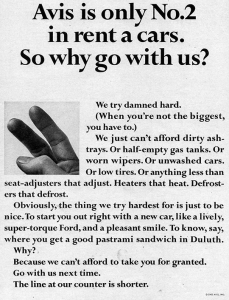
There’s always something good about where you are, so don’t lie to your audience to make it seem better. What most people don’t realize is that all it takes is for you to be honest and humble. Because when you are, people have an easier time resonating with your brand and trusting it.
Sure, being transparent isn’t easy, especially for large corporates that have been secretive for several decades, because being so means that you expose both the negative and positive aspects of your brand, and many people can’t stand that in fear of losing their customers.
But what they don’t realize is that they lose customers by trying to hide bad publicity under the carpet rather than meeting the complaints and publicity.
The bottom line is that you should never use boring sentences like ”the best in the market” unless you have the facts to back it up, because today, everyone is using those terms, meaning that they’ve lost efficiency.
Let your audience in behind the scenes
Letting people in behind the scenes is a tremendous way to make your brand more transparency.
After all, it is what happens behind the curtains that is the real transparency.
Why do you think champagne and wine brands offer tours to their wine cellars and vineyards?
To build a better connection with their audience, to become more transparent, and because they take pride in their creation process.
And the thing is, if you aren’t transparent with how you manufacture your products, or what happens behind the scenes, people will believe that you have something to hide, or that you aren’t proud of your creation process.
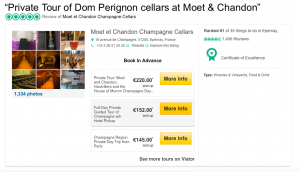
Showing how you create something is the ultimate way to show that you are proud of what you are selling. And when you take pride in what you are selling, your customers will, too!
Of course, it’s not always possible to offer tours in your factory or the place where you manufacture your products, however, that does not stop you from photos and videos from those places.
What’s more, it does not stop you either from showing the people who are on your team, and the people who make the brand possible. Doing so shows your audience that there are real people working at your brand, which will allow you to connect with them on a more personal level. People build relationships with humans, not logos.
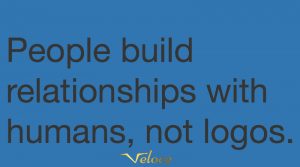
There’s a fine line between being personal and losing the sense of professionalism you should have as a business.
Give your audience an insight into how you are working behind the scenes to make the things your customers are using possible, but don’t lose your sense of professionalism by oversharing or sharing unserious or unprofessional parts.
Another thing that is great to share is throwbacks to how it all started. When you show your audience that you started just like any other business with very little resources, people will have more respect for your brand, as well as establish more trust in it.
The first reason to why it is good to share photos of your team is that it gives a face to your brand. This is especially important if your brand is only online. A face makes your brand more human, and easier to resonate with.
Secondly, having a face when interacting with them allows your customers to have a better conversation with you. For example, if a customer is extremely angry and takes out their anger on you, most people won’t have any problem doing so because it’s so abstract. THey’re just talking to someone somewhere. However, when they are talking to Lily with brown hair, people realize that it’s just another person like you and me, and not only will they have an easier time resonating with your brand, but they’ll also shy away from taking their anger out on someone who is just trying to do their job.
Just take a look at this email conversation taking place between two people as a result of a complaint that the brand receives. It’s mind-blowing how the conversation completely turned around:
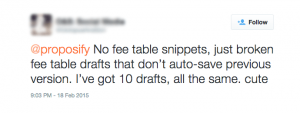
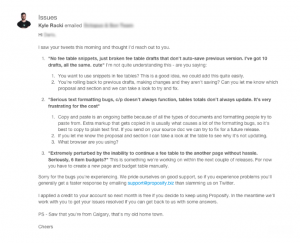
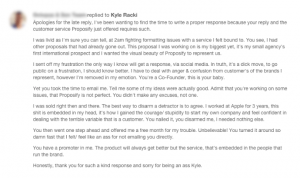
A lot of it was thanks to Kyle’s response, but we cannot deny the fact that it became a lot more concrete when the person complaining talked with Kyle Racki – someone who has lived in Calgary, the complainer’s old hometown.
Admit your mistakes
Everyone knows that no-one is perfect – especially not brands, so don’t pretend like you are.
Not admitting your mistakes or flaws is the ultimate way to scare away your audience and to harm your transparency.
Whether you like it or not, you’re going to make mistakes
Mistakes happen. Sometimes they aren’t avoidable and sometimes they are. For whatever the reason, owning up to the mistakes that you, your staff, or your company has made is a must to gain the trust of your clientele. Many times, employees can get overly defensive when they are confronted with an error that was made by them. Instead of coming up with excuses for why you did what you did, apologize for the mistake and think of how you can fix it. Not only is this a rule that should be followed in our everyday lives, it also is an excellent business practice that your customers will appreciate.
Take a look at how Asos made a mistake with their automated responses on Facebook, but instead of admitting that it was an automated response, they deny it and make another mistake.
After all, no-one complained or asked for any help.
Ouch.

When you make mistakes, admit it and show that you are doing everything you can to prevent it from happening again. This approach is far more effective than pretending like you’re flawless and never commit mistakes.
Because if you do, people have a harder time resonating with you, and ultimately establishing trust in you.
Share sneak-peaks
When you give exclusive sneak-peaks and behind-the-scenes looks, they’ll get a peek into reality as well as feel selected and unique. Not only does giving your audience sneak peaks, for example on a new product make your brand more transparent, but it also builds up hype and speed of the buyer journey.
When you give sneak peaks to a selected number of people, for instance as a benefit, you’ll able to drive more engagement to when the launch will be taking place.
Ideally, for making your brand extremely transparent, you should show the whole journey of the creation process. From designing to developing, to producing. Of course, many times, this isn’t possible, as it is the grand unveiling that builds the hype, however, some small sneak peaks that makes your audience more engaged in your brand, and gives them a better understanding of how your brand operates won’t hurt.
Be honest
Honesty is the best policy.
Especially for brands.
Yet, it seems like brands are the ones that are lying the most. Or at least talking half-truths.
In making your brand more transparent, the best way is to be more honest.
It’s simple, really.
In the example with Coca-Cola’s FAQs, their answer wasn’t really much help. In fact, it didn’t answer the question that the customer asked.
Only, only, only, give the full truth and nothing but the truth.
Would you trust someone who has lied to you over and over?
Of course, you wouldn’t!
But would you trust someone who has told you nothing but the truth at all times?
Of course.
Honesty means that you become more transparent, which in turn leads to established trust, which in turn leads to more sales.
Lying as a brand worked okay back in the days because people had a limited access to information and reviews etc, and therefore, brands could lie in a completely different way than they can today. And if you lie, people can most of the time quickly look up the truth. And if it turns out you are lying, people will lose trust in you. And you are telling the truth, people will trust you more.
People hate hearing things like:
- We are the cheapest car service company on the market
- The world’s most delicious food
- All American’s favorite
Instead, change it to:
- Our car services start at the competitive price of $20
- Winner of the ”world’s best food award” two times
- Tried by 10 million Americans
Do you see the difference?
Transparency about sourcing
There’s a great interest from the consumers to know where their products are made, how they are made, and what effect they have had on the environment. Back in the days, only a few brands shared this type of information, but today, it has almost been forced by the market, especially regarding the clothing industry. And now, almost all brands have a transparency about sourcing more or less.
Some years ago scandals about sweatshops were revealed, and this has put an even greater demand from the consumer’s side to be able to shop ethically, and products that have been made in factories with humane working conditions.
Everlane is one of the top brands in the clothing industry when it comes to being transparent about sourcing.
Every item on their website contains information about where it has been manufactured, as well as a story about the factory.
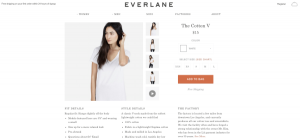
On a separate page, Everlane shows all of their factories on a map, and where they are located
When brands are this transparent about their sourcing, customers feel a lot better and more happy with they are buying, because they can be sure that the product they’ve bought has been made under good conditions. They have even created the hashtag #KnowYourFactories to put pressure on other brands in the industry, as well as show that they put great emphasis on it.
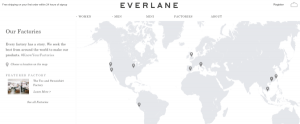
In fact, Everlane, apart from presenting all the factories that they source from, also answers questions that customers might come to ask, for example, how they found the factory.
Regarding one factory, they talk about transparency:
”Before Everlane launched, we knew we wanted to create a beautiful silk blouse. We were inspired by the $200 shirts we saw at high-end department stores but wanted to bring a transparent price to our customers. We started our search determined to find the same factory that produced these blouses.”
And this shows that they have made an active choice to be more transparent because they know that is what their customers want.
When you show where you source products from, not only will you make your brand become more transparent, but your customers will also feel good about what it is they are buying.
An example of transparency done right
A brand that has embraced transparency is SpaceX.
Instead of hiding their failures, they share them with their audience on social media and their website. And considering the fact that they are trying to break new grounds and completely revolutionize space travel, you can expect that there are quite a few failures. But that doesn’t matter because, in one way, failing means winning.
Of course, if they would only share the failures, people would think that failures are all they can. Therefore, they also share the positive sides, and successes they have with their work of revolutionizing the future.
In fact, on YouTube, they have even made a compilation of all the crashes they’ve had and titled the video ”How Not to Land an Orbital Rocket Booster”.
Now that’s transparency at the very highest level.
Conclusion
Transparency is tremendously effective in marketing.
Not all brands are embracing transparency in fear of losing their sense of professionalism, but those that do see tremendous success.
The market asks brands to be more transparent, and if you give your customers what they want, they’ll become more engaged in your brand.
When you are hiding everything from your customers, and trying to keep everything hidden, people will feel like you have something you hide.
And if you aren’t transparent in your marketing, maybe you do have something to hide?
How are you using transparency in marketing? What tactics are you using to reduce the gap between brand and customer?


